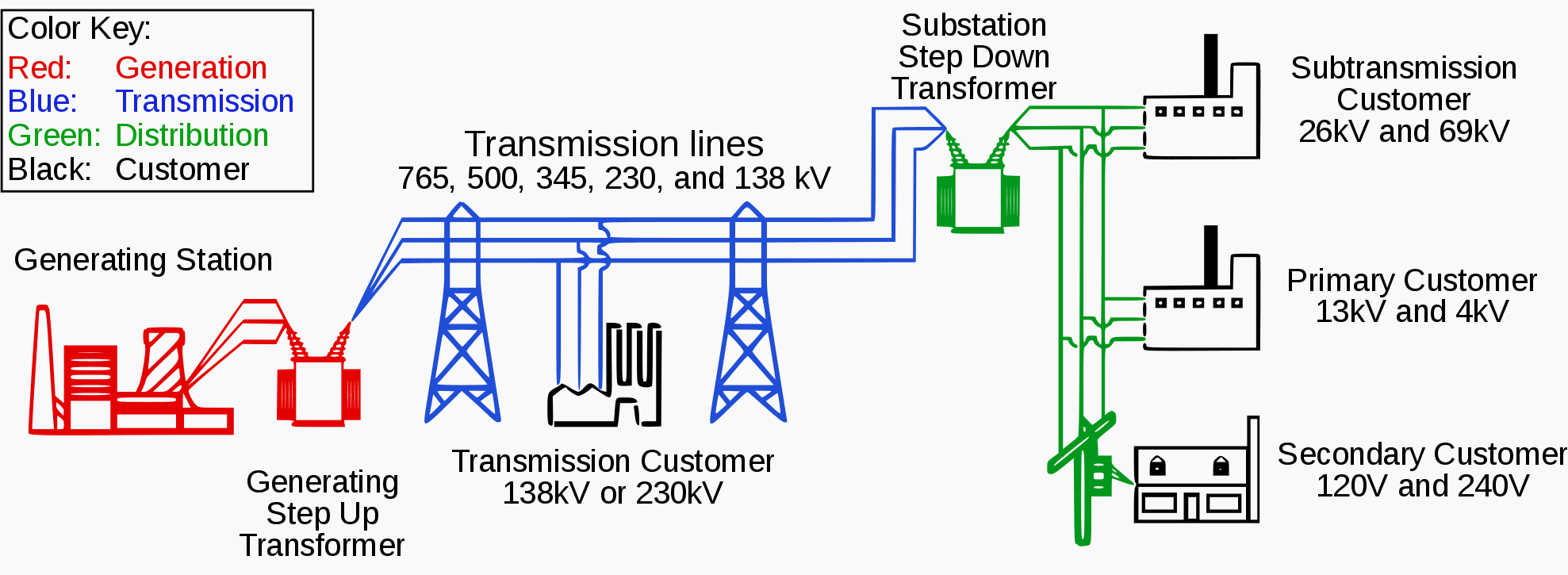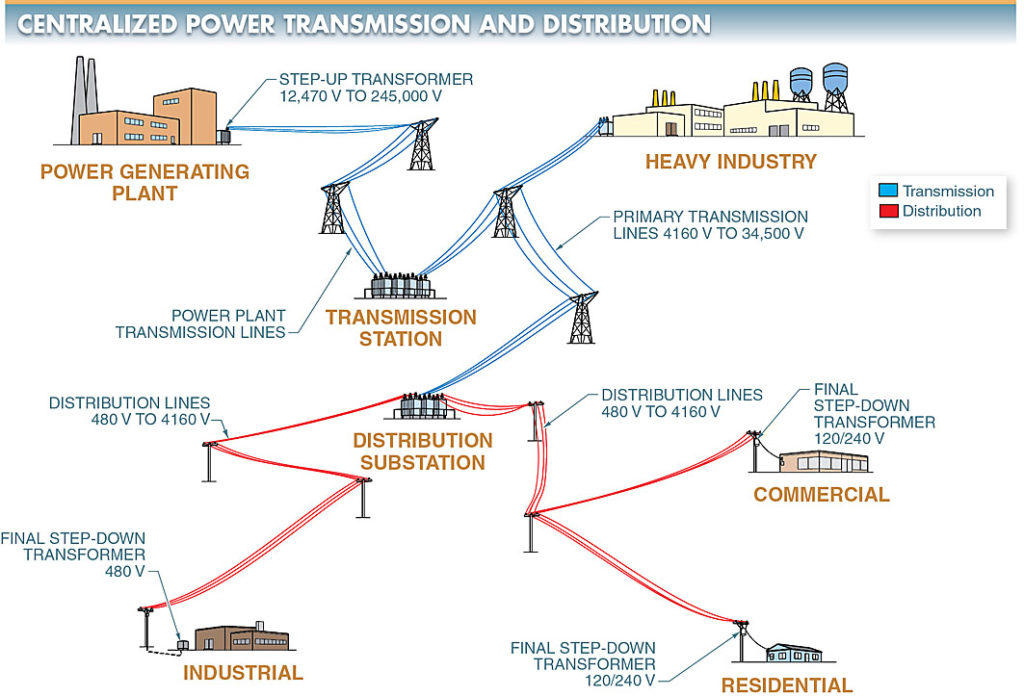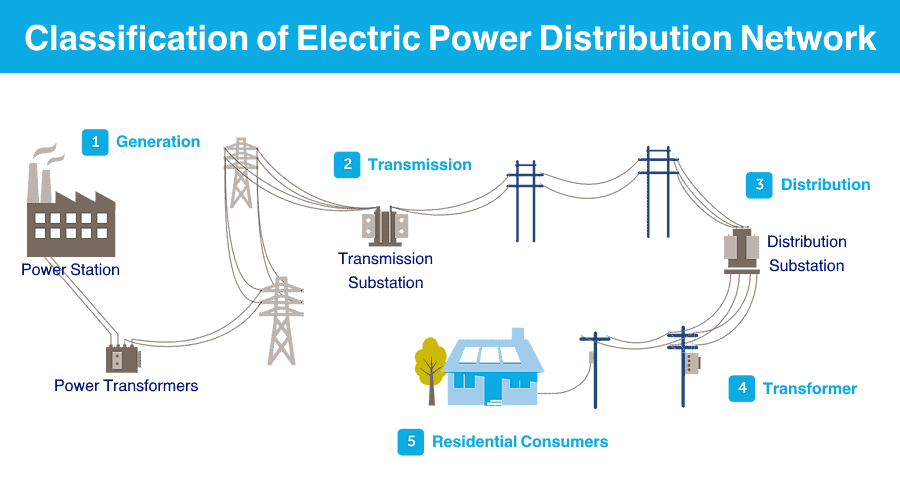What is grid in power system – What is a grid in power system? A power grid, also known as an electrical grid, is a network of interconnected components that transmit and distribute electricity from generating sources to end users. It plays a crucial role in the reliable and efficient delivery of electricity to homes, businesses, and industries.
Power grids are essential for modern society, enabling the flow of electricity over vast distances and ensuring a stable and continuous supply of power. They are complex systems that require careful planning, design, and operation to meet the ever-increasing demand for electricity.
Definition of Grid in Power System

In the realm of electricity, a grid is an interconnected network of transmission lines, substations, and distribution systems that facilitates the efficient flow of electricity from power plants to consumers.
The significance of a grid lies in its ability to ensure a reliable and stable supply of electricity to homes, businesses, and industries. It allows for the seamless integration of various power sources, such as fossil fuels, renewable energy, and nuclear power, optimizing their utilization and minimizing disruptions.
Components of a Grid
- Transmission Lines:High-voltage lines that transmit electricity over long distances from power plants to substations.
- Substations:Electrical installations that transform voltage levels, ensuring efficient distribution of electricity to different regions.
- Distribution Lines:Lower-voltage lines that deliver electricity to homes, businesses, and industries.
Types of Grids
Power systems employ various types of grids to efficiently transmit and distribute electricity. These grids differ in their scale, connectivity, and functionality, catering to specific requirements and geographic regions.
Interconnected Grids
Interconnected grids are vast networks that span multiple regions or countries. They facilitate the exchange of electricity between different areas, enhancing reliability and optimizing resource utilization. For example, the European Grid, one of the world’s largest interconnected grids, connects over 40 countries and enables the sharing of renewable energy sources.
Microgrids
Microgrids are small, localized grids that typically serve a specific community or facility. They operate independently from the main grid and can integrate distributed energy resources such as solar panels or wind turbines. Microgrids provide resilience during power outages and reduce reliance on centralized generation.
Smart Grids
Smart grids incorporate advanced technologies to enhance grid efficiency, reliability, and consumer engagement. They utilize sensors, communication networks, and data analytics to optimize energy flow, reduce losses, and empower consumers with real-time information about their energy consumption.
Components of a Grid: What Is Grid In Power System

The power grid is a complex system that delivers electricity from generating stations to consumers. It consists of several major components, including:
Generation sources
These are the facilities that produce electricity, such as power plants, solar farms, and wind turbines.
Transmission lines
These are high-voltage lines that carry electricity from generating stations to substations.
Substations
These are facilities that transform the voltage of electricity and distribute it to local areas.
Distribution networks
These are the low-voltage lines that deliver electricity to homes and businesses.These components work together to deliver electricity to consumers in a reliable and efficient manner. The generation sources produce electricity, which is then transmitted to substations. The substations transform the voltage of the electricity and distribute it to local areas.
The distribution networks then deliver the electricity to homes and businesses.
Generation Sources
The most common type of generation source is a power plant. Power plants use a variety of fuels, such as coal, natural gas, and nuclear energy, to produce electricity. Other types of generation sources include solar farms, wind turbines, and hydroelectric dams.
Transmission Lines
Transmission lines are high-voltage lines that carry electricity from generating stations to substations. They are typically made of aluminum or copper and are supported by towers. Transmission lines can be hundreds of miles long.
Substations
Substations are facilities that transform the voltage of electricity. They are typically located near generating stations and distribution networks. Substations use transformers to increase or decrease the voltage of electricity.
Distribution Networks
Distribution networks are the low-voltage lines that deliver electricity to homes and businesses. They are typically made of copper or aluminum and are supported by poles. Distribution networks can be several miles long.
Grid Architecture
Grid architecture refers to the physical and logical arrangement of components within a power grid. Different architectures offer varying levels of reliability, efficiency, and flexibility. The most common grid architectures include radial, loop, and meshed networks.
Radial Networks
- Power flows from a central source to multiple loads in a tree-like structure.
- Simple and cost-effective to build and maintain.
- Limited redundancy and reliability, as outages at the central source affect all downstream loads.
Loop Networks
- Power flows in multiple directions through closed loops.
- Increased reliability compared to radial networks, as multiple paths for power flow exist.
- More complex to design and operate, and can lead to circulating currents.
Meshed Networks
- Power flows through a fully interconnected network of nodes and lines.
- Highest level of reliability and flexibility, as multiple paths for power flow exist.
- Most complex and expensive to build and maintain, and can lead to higher power losses.
Grid Operations
Grid operations are critical to the reliable and efficient delivery of electricity to consumers. They involve managing the flow of power, maintaining voltage stability, and responding to faults.
Load balancing is a key aspect of grid operations. It ensures that the power generated matches the demand from consumers. This is achieved by adjusting the output of power plants and shifting loads between different parts of the grid.
Voltage regulation is another important aspect of grid operations. It ensures that the voltage at consumers’ premises remains within acceptable limits. This is achieved by using transformers and other equipment to adjust the voltage as needed.
Fault management is also a critical aspect of grid operations. Faults can occur anywhere on the grid, and they can cause power outages if not handled properly. Grid operators use a variety of techniques to detect and isolate faults, and to restore power as quickly as possible.
Challenges and Strategies for Maintaining Grid Stability
Maintaining grid stability is a complex challenge. The grid is a constantly changing system, and it is subject to a variety of disturbances, such as changes in demand, outages, and faults. To maintain stability, grid operators use a variety of strategies, including:
- Monitoring the grid in real time
- Predicting and forecasting changes in demand
- Adjusting the output of power plants
- Shifting loads between different parts of the grid
- Using backup generators
- Implementing demand response programs
Grid Monitoring and Control
Grid monitoring and control systems play a crucial role in maintaining the stability, reliability, and efficiency of power grids. These systems monitor the state of the grid in real-time, allowing operators to make informed decisions and take corrective actions to prevent or mitigate any potential disruptions.
Real-time data collection and analysis are essential for effective grid operations. Sensors and meters installed throughout the grid collect data on voltage, current, frequency, and other parameters. This data is then transmitted to a central control center, where it is processed and analyzed using advanced software tools.
Supervisory Control and Data Acquisition (SCADA)
SCADA systems are the backbone of grid monitoring and control. They provide a real-time view of the grid’s state, enabling operators to monitor and control equipment remotely. SCADA systems typically consist of:
- Remote Terminal Units (RTUs): Collect data from sensors and meters in the field.
- Master Terminal Units (MTUs): Receive and process data from RTUs and send control commands to field devices.
- Human-Machine Interface (HMI): Provides operators with a graphical representation of the grid and allows them to interact with the system.
Energy Management Systems (EMS)
EMSs are more advanced than SCADA systems and provide additional capabilities for grid optimization. They use mathematical models to simulate grid behavior and optimize the flow of electricity. EMSs can:
- Predict load demand and generation output.
- Identify and resolve potential grid constraints.
- Dispatch generation resources to meet demand while minimizing costs.
Importance of Real-Time Data Collection and Analysis
Real-time data collection and analysis are essential for grid operations for several reasons:
- Early detection of grid disturbances:Real-time data allows operators to identify potential grid disturbances at an early stage, enabling them to take corrective actions before they escalate.
- Optimal grid operation:Real-time data helps operators optimize grid operations by identifying and resolving bottlenecks, reducing congestion, and improving the overall efficiency of the system.
- Improved reliability:Real-time data enables operators to monitor the condition of grid equipment and identify potential failures before they occur, reducing the risk of outages.
Grid Protection
Power grids are vulnerable to various faults, disturbances, and cyberattacks. To protect the grid, a comprehensive set of protection measures are employed. These measures include the use of protective relays, circuit breakers, and other protective devices.
Protective Relays
Protective relays are devices that detect abnormal conditions in the power grid and initiate appropriate actions to isolate the affected area. They operate based on various parameters, such as overcurrent, overvoltage, underfrequency, and rate of change of frequency. When a relay detects an abnormal condition, it sends a trip signal to circuit breakers, which interrupt the flow of electricity in the affected area.
Circuit Breakers
Circuit breakers are electromechanical devices that interrupt the flow of electricity in response to a trip signal from a protective relay. They are designed to operate quickly and reliably, isolating the affected area from the rest of the grid. Circuit breakers can be manually or automatically operated, depending on the specific application.
Other Protective Devices
In addition to protective relays and circuit breakers, a variety of other protective devices are used to enhance grid protection. These devices include surge arresters, which protect against overvoltages caused by lightning or other events; fuses, which protect against overcurrents; and reclosers, which automatically reclose after a fault has been cleared to restore power to the affected area.
Grid Modernization
Grid modernization involves upgrading and transforming existing power grids to improve their efficiency, reliability, and resilience. It incorporates advanced technologies and strategies to enhance grid operations and integrate new energy sources.The modernization of power grids is driven by several trends and technologies, including the increasing penetration of renewable energy sources, distributed generation, and the growing adoption of smart technologies.
These factors necessitate a more flexible and adaptable grid infrastructure that can accommodate intermittent power sources and manage the increasing complexity of grid operations.
Integrating Renewable Energy Sources
Integrating renewable energy sources, such as solar and wind power, into the grid presents challenges due to their intermittent nature. Grid modernization efforts focus on developing technologies and strategies to forecast renewable energy generation, optimize grid operations, and ensure grid stability.
Distributed Generation
The rise of distributed generation, where power is generated at or near the point of consumption, requires a more decentralized and flexible grid infrastructure. Grid modernization initiatives aim to integrate distributed generation systems into the grid, optimize their operation, and manage the potential impacts on grid stability.
Smart Technologies
Smart technologies, such as smart meters, sensors, and advanced control systems, play a crucial role in grid modernization. These technologies provide real-time data and enable advanced grid monitoring and control, optimizing grid operations, and enhancing grid resilience.
Future of the Grid
The future of power grids is expected to be shaped by several key trends, including advancements in technology, the increasing adoption of distributed energy resources (DERs), and the rising demand for electricity.
One of the most significant advancements in grid technology is the development of smart grids. Smart grids use sensors, communication networks, and advanced control systems to monitor and control the flow of electricity in real time. This allows utilities to improve the efficiency and reliability of the grid, as well as integrate DERs more effectively.
Distributed Energy Resources
The increasing adoption of DERs, such as solar panels and wind turbines, is also expected to have a major impact on the future of the grid. DERs can help to reduce the need for centralized power generation and make the grid more resilient.
However, they also pose challenges for grid operators, as they can be intermittent and variable.
Increasing Demand for Electricity, What is grid in power system
The rising demand for electricity is another major trend that is expected to shape the future of the grid. The electrification of transportation and heating is expected to drive a significant increase in electricity demand in the coming years. This will require the grid to be expanded and upgraded to meet the growing demand.
The future of the grid is complex and uncertain, but it is clear that the grid will need to evolve to meet the challenges and opportunities of the 21st century.
Epilogue

As the demand for electricity continues to grow, power grids are undergoing significant modernization efforts. The integration of renewable energy sources, distributed generation, and smart technologies is transforming the grid into a more resilient, efficient, and sustainable system. The future of the grid holds exciting possibilities, with advancements in technology and innovation promising to revolutionize the way we generate, distribute, and consume electricity.
Commonly Asked Questions
What are the main components of a power grid?
The main components of a power grid include generation sources (e.g., power plants), transmission lines, substations, and distribution networks.
What are the different types of power grids?
There are various types of power grids, including interconnected grids, microgrids, and smart grids, each with its own characteristics and applications.
How is electricity transmitted over long distances?
Electricity is transmitted over long distances using high-voltage transmission lines, which minimize energy losses during transmission.
What is the role of substations in a power grid?
Substations play a crucial role in transforming voltage levels, switching power between different circuits, and protecting the grid from faults.
